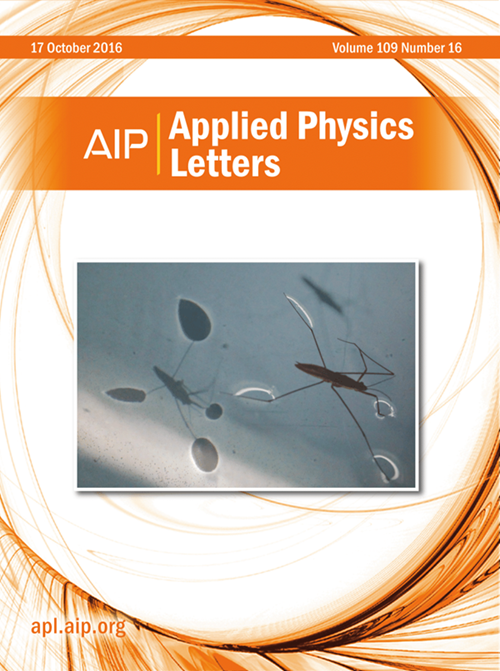4H-SiC中空位缺陷形成的计算导向实验验证
IF 3.5
2区 物理与天体物理
Q2 PHYSICS, APPLIED
引用次数: 0
摘要
最近对量子信息科学的固态量子比特的研究主要集中在光学可寻址的自旋缺陷上,如金刚石中的负电荷氮空位中心和4H-SiC中的中性电荷空位(VV),作为可扩展的量子传感器和网络量子比特。在这种背景下,对4H-SiC中VV中心子集的结构起源和缺陷形成动力学的直接研究仍然缺乏。本文采用系统的实验方法,在第一性原理模拟预测的指导下,对4H-SiC中VV缺陷的形成和控制进行了全面的机制理解。研究了退火时间和温度对电子辐照后高纯度半绝缘4H-SiC样品中VV形成的影响。选择三种不同的温度(1123、1273和1473 K)和退火时间(0.5 ~ 72 h)来探索不同区域的VV形成。我们发现在1273 K退火的样品具有最高的vv相关光致发光(PL)强度,这与第一性原理计算的预测一致。此外,1273 K下与VV相关的PL强度与退火时间的对数关系表明,1273 K为硅空位迁移提供了足够的热能,而不是为VV迁移提供了足够的热能。总之,这些结果表明,有效的VV形成发生在VSi迁移温度以上和VV迁移阈值以下。本文章由计算机程序翻译,如有差异,请以英文原文为准。
Computationally guided experimental validation of divacancy defect formation in 4H-SiC
Recent research into solid-state qubits for quantum information science has focused on optically addressable spin defects such as the negatively charged nitrogen-vacancy center in diamond and the neutrally charged divacancy (VV) in 4H-SiC as scalable quantum sensors and networking qubits. Within this context, direct investigations of the structural origin and defect formation dynamics of a sub-set of the VV center in 4H-SiC remain lacking. Here, we take a systematic experimental approach guided by predictions from first-principles simulations to gain a thorough mechanistic understanding of the VV defect formation and control in 4H-SiC. We study the effect of annealing time and temperature on VV formation in high-purity semi-insulating 4H-SiC samples following electron irradiation. Three different temperatures (1123, 1273, and 1473 K) and annealing duration (from 0.5 to 72 h) are chosen to explore VV formation in different regions. We find that samples annealed at 1273 K give the highest VV-related photoluminescence (PL) intensities, in agreement with the prediction from first-principles calculations. Furthermore, the logarithmic dependence of VV-related PL intensities on the annealing duration at 1273 K indicates that 1273 K provides sufficient thermal energy for silicon vacancy migration but not for VV migration. Together, these results suggest that efficient VV formation occurs above the VSi migration temperature and below the VV migration threshold.
求助全文
通过发布文献求助,成功后即可免费获取论文全文。
去求助
来源期刊

Applied Physics Letters
物理-物理:应用
CiteScore
6.40
自引率
10.00%
发文量
1821
审稿时长
1.6 months
期刊介绍:
Applied Physics Letters (APL) features concise, up-to-date reports on significant new findings in applied physics. Emphasizing rapid dissemination of key data and new physical insights, APL offers prompt publication of new experimental and theoretical papers reporting applications of physics phenomena to all branches of science, engineering, and modern technology.
In addition to regular articles, the journal also publishes invited Fast Track, Perspectives, and in-depth Editorials which report on cutting-edge areas in applied physics.
APL Perspectives are forward-looking invited letters which highlight recent developments or discoveries. Emphasis is placed on very recent developments, potentially disruptive technologies, open questions and possible solutions. They also include a mini-roadmap detailing where the community should direct efforts in order for the phenomena to be viable for application and the challenges associated with meeting that performance threshold. Perspectives are characterized by personal viewpoints and opinions of recognized experts in the field.
Fast Track articles are invited original research articles that report results that are particularly novel and important or provide a significant advancement in an emerging field. Because of the urgency and scientific importance of the work, the peer review process is accelerated. If, during the review process, it becomes apparent that the paper does not meet the Fast Track criterion, it is returned to a normal track.
 求助内容:
求助内容: 应助结果提醒方式:
应助结果提醒方式:


